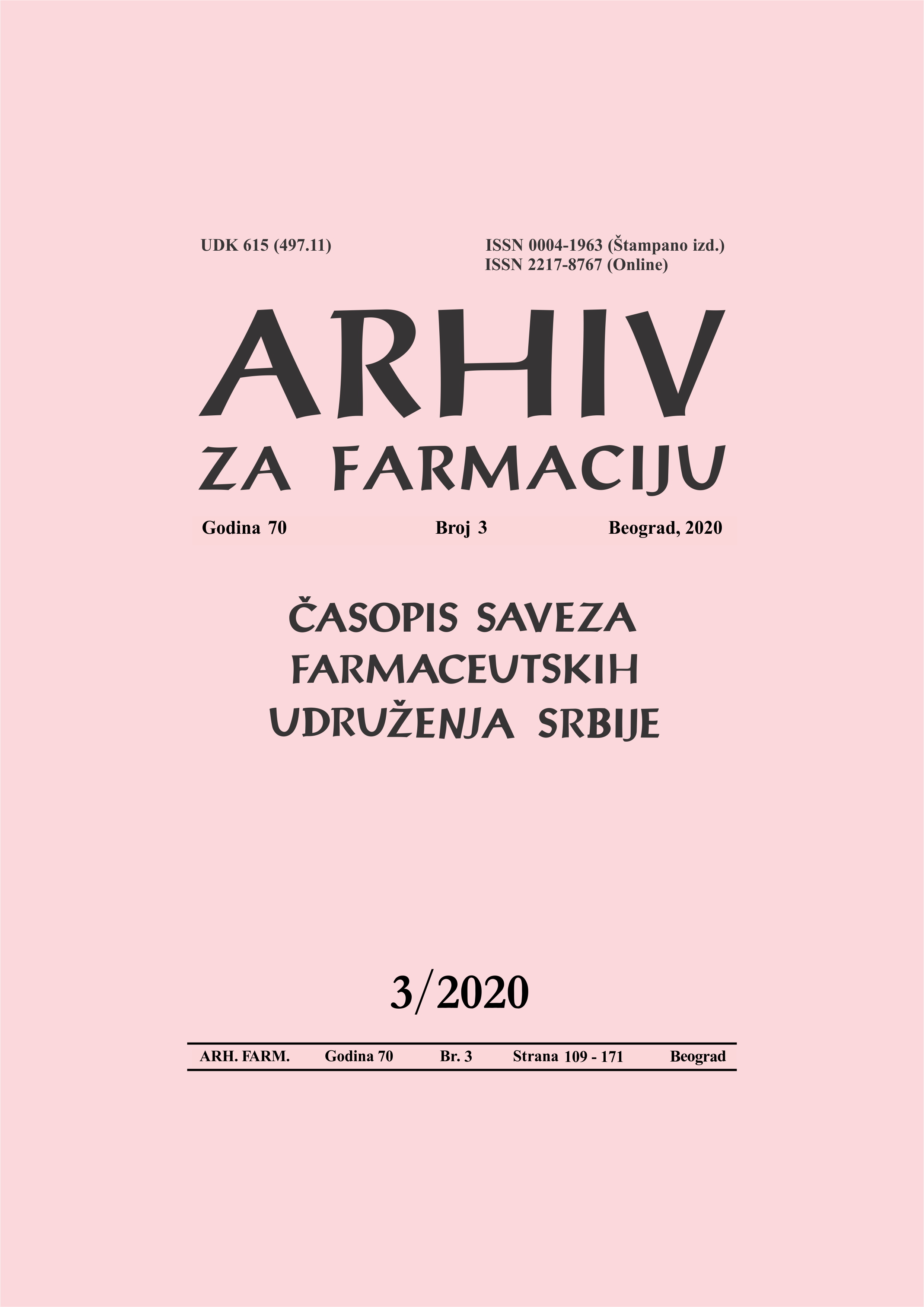Chemometric window to antimicrobial activity of biomolecules isolated from endophytic fungi
Abstract
Drug resistance, especially bacterial antibiotic resistance, is recognized as a global phenomenon. Potential of endophytic fungi as producers of secondary metabolites with wide spectra of different bioactivities in the field of drug discovery has recently been introduced. The production of these compounds is under the great impact of the variety of factors related to the choice of plant host, climate conditions, nutrition, presence of other microorganisms in the same surrounding, etc. Due to a large number of different indices of endophytic fungi antibacterial activity, critical evaluation with the assistance of data mining analytical methods was performed. The activity towards several pathogen bacteria of endophytes species growing on different plant hosts, deciduous trees as well as herbaceous plants spread worldwide in different climatic zones together with the taxonomy of endophytes was taken into consideration. The principal component analysis was used to explore formed big data set and through finding patterns in data, to point out to a limited number of proper candidates for future pharmaceutical research. The antimicrobial character of Phomopsis species was highlighted and future perspectives in their therapeutic use were projected.
References
Radić N, Štrukelj B. Endophytes fungi – The treasure chest of antibacterial substances. Phytomedicine. 2012; 19: 1270-84.
Martinez-Klimova E, Rodriguez-Pena K, Sanchez S. Endophytes as source of antibiotics. Biochem. Pharmacol. 2017; 134: 1-17.
Yu H, Zhang L, Li L, Zheng C, Guo L, Li W et al. Recent developments and future prospects of antimicrobial meabolites produced by endophytes. Microbiol. Res. 2010; 165: 437-49.
Wink M. Evolution of secondary metabolites from an ecological and molecular phylogenetic perspective. Phytochemistry. 2003; 64: 3-19.
Nisa H, Kamili AN, Nawchoo IA, Shafi S, Shameem N, Bandh SA. Fungal endophytes as prolific source of phytochemicals and other bioactive natural products: A review. Microb. Pathogenesis. 2015; 82: 50-9.
Schulz B, Boyle C, Draeger S, Römmert AK, Krohn K. Review: Endophytic fungi: a source of novel biologically active secondary metabolites. Mycol. Res. 2002, 106, 996-1004.
Kusari S, Hertweck C, Spiteller M. Chemical ecology of endophytic fungi: origins of secondary metabolites.Chem. Biol. 2012; 19: 792-8.
Udayanga D, Liu X, McKenzie EH, Chukeatirote E, Bahkali AH, Hyde KD, The genus Phomopsis: biology, applications, specie concepts and names of common phytopathogens. Fungal Divers. 2011; 50: 189-225.
Arnold AE, Mejía LC, Kyllo D, Rojas EI, Maynard Z, Robbins N, Herre EA. Fungal endophytes limit pathogen damage in a tropical tree. Proc. Nat. Acad. Sci. 2003; 100: 15649-54.
G. A. Strobel GA, Endophytes as sources of bioactive products. Microb. Infect. 2003; 5: 535-44.
Ryan RP, Germaine K, Franks A, Ryan DJ, Dowling DN. Bacterial endophytes: recent developments and applications. FEMS Microb. Lett. 2008; 278 (1): 1-9.
Tan RX, Zou WX. Endophytes: a rich source of functional metabolites. Nat. Prod. Rep. 2001; 18: 448-59.
Deng Z, L. Cao L. Fungal endophytes and their interactions with plants in phytoremediation: A review. Chemosphere. 2017; 168: 1100-06.
S. L. Doty. Enhancing Phytoremediation through the Use of Transgenics and Endophytes. New Phytologist. 2008; 179: 318-33.
Ravnikar M, Tercelj M, Janeš D, Štrukelj B, Kreft S. Antibacterial activity of endophytic fungi isolated from conifer needles. Afr. J. Biotech. 2015; 14: 867-71.
Diogo EL, Santos JM, Phillips AJ. Phylogeny, morphology and pathogenicity of Diaporthe and Phomopsis species on almond in Portugal. Fungal Divers. 2010; 44: 107-15.
Farr DF, Castlebury LA, Rossman AY. Morphological and molecular characterization of Phomopsis vaccinii and additional isolates of Phomopsis from blueberry and cranberry in the eastern United States. Mycologia. 2002; 94: 494-504.
Mutihac L, Mutihac R. Review, Mining in chemometrics. Anal. Chim. Acta. 2008; 612: 1–18.
Shin EC, Craft B, Pegg R, Dixon Phillips R, Eitenmiller R. Chemometric approach to fatty acid profiles in Runner-type peanut cultivars by principal component analysis (PCA). Food chem. 2010; 119: 1262-70.
Joliffe T. Principal Components Analysis. New York: Springer; 1986.
Wold S. Principal Components Analysis. Chemometr. Intell. Lab. Syst. 1987; 2 (1-3): 37-52.
Ignjatović J, Maljurić N, Golubović J, Ravnikar M, Petković M, Savodnik N et al. Characterization of Biomolecules with Antibiotic Activity from Endophytic Fungi Phomopsis Species. Acta Chim. Slov. 2020; 67: 5389.
Kollar Hunek K, Heberberger K. Method and model comparison by sum of ranking differences in cases of repeated observations (ties). Chemometr. Intell. Lab. Syst. 2013; 127: 139-46.
Hussain H, Tchimene MK, Ahmed I, Meier K, Steinert M, Draeger S. et al. Antimicrobial chemical constituents from the endophytic fungus Phomopsis sp. from Notobasis syriaca Nat. Prod. Commun. 2011; 6: 1905-6.
Corrado M, Rodrigues KF. Antimicrobial evaluation of fungal extracts produced by endophytic strains of Phomopsis sp. J. Basic. Microb. 2004; 44 (2): 157-60.
Isaka M, Jaturapat A, Rukseree K, Danwisetkanjana K, Tanticharoen M, Thebtaranonth Y. Phomoxanthones A and B, novel xanthone dimers from the endophytic fungus Phomopsis species. J. Nat. Prod. 2001; 64 (8): 1015-8.
Jayanthi G, Kamalraj S, Karthikeyan K, Muthumary J. Antimicrobial and antioxidant activity of the endophytic fungus Phomopsis sp. GJJM07 isolated from Mesua ferrea. Int. J. Curr. Sci. 2011; 1: 85-90.
Rakshith D, Santosh P, Satish S. Isolation and characterization of antimicrobial metaboliteproducing endophytic Phomopsis sp. From Fisus pumila Linn. Int. J. Chem. Anal. Sci. 2013; 4: 156-60.
Rukachaisirikul V, Sommart U, Phongpaichit S, Sakayaroj J, Kirtikara K. Metabolites from the endophytic fungus Phomopsis sp. PSU-D15. Phytochemistry. 2008; 69 (3): 783-7.
Yen TW, Lee CC, Ibrahim D, Zakaria L. Enhancement of anti-candidal activity of endophytic fungus Phomopsis sp ED2, isolated from Orthosiphon stamineus Benth, by incorporation of host plant extract in culture medium. J. Microbiol. 2012; 50 (4): 581-5.

